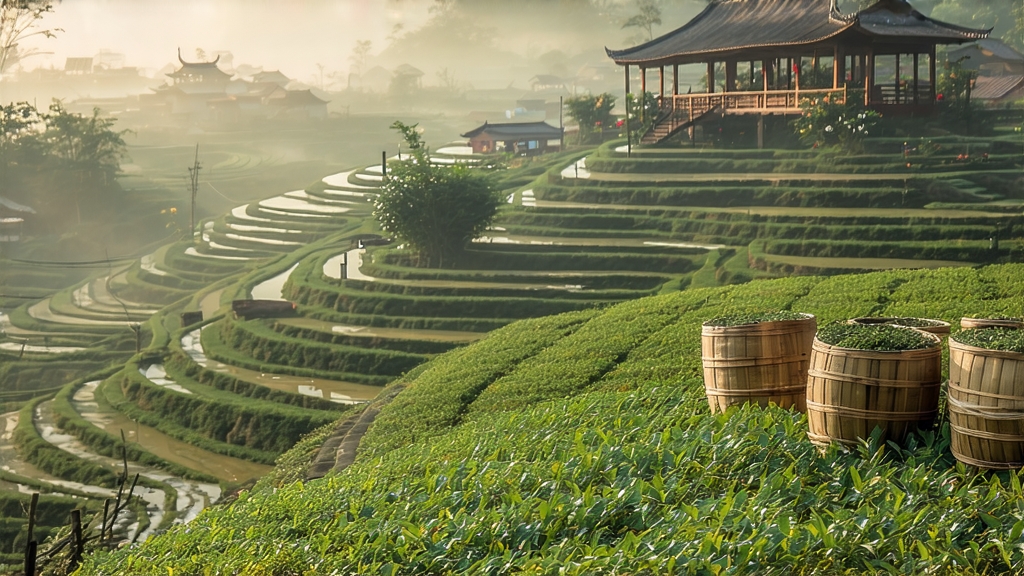
Tucked into the creases of southern Guangxi’s Wuzhou prefecture, Liu Bao tea has spent four centuries quietly perfecting the art of patience. While Pu-erh has become the global shorthand for Chinese post-fermented tea, Liu Bao—older by at least a hundred years—remains a well-kept secret among porters, river men, and a handful of Hong Kong tea merchants who still call it “the coolie’s tonic.” This article invites the international reader to discover why Liu Bao is not merely another dark tea, but a living archive of Ming-era trade routes, microbial terroir, and the subtle alchemy of time.
-
Historical currents
Liu Bao takes its name from the small administrative village of Liu Bao, once the last navigable stop on the Yujiang River before the rapids that led to Guangdong. From the late Ming onward, tea grown on the granite slopes of the Dayao Mountains was steamed, pressed, and loaded onto bamboo rafts bound for Guangzhou and, eventually, Southeast Asia. British port records from 1850 list “Lew Pow” alongside Keemun and Lapsang Souchong, but at one-third the price, destined for coolie camps from Singapore to the gold fields of Victoria. The humid holds of junks acted as mobile cellars; after months at sea the tea arrived darker, smoother, and oddly revitalizing, earning a reputation for curing dysentery and heat fatigue. When the river trade silted up in the 1950s, Liu Bao retreated into domestic obscurity until the 2006 renaissance when Guangxi researchers rediscovered its unique microbial profile. -
Terroir and leaf
The authentic micro-zone spans only 500 km² at 200–800 m elevation where red lateritic soil, high humidity, and frequent radiation fog create a natural greenhouse for the large-leaf Camellia sinensis var. sinensis f. pubilimba. Locals divide the hills into “three villages and five hamlets,” each producing leaf with slightly different polyphenol ratios. The most coveted gardens, such as Tangping and Xianren, are scattered with wild camphor and cinnamon trees whose roots share mycorrhizal networks with the tea bushes, foreshadowing the tea’s signature cooling finish. -
Craft: from kill-green to wet pile
Harvest begins after Qingming when two leaves and a bud reach 8–10 cm. The first steps look orthodox: solar withering, 280 °C wok kill-green, and a 40-minute rolling session to rupture 60 % of cell walls. The divergence happens the following night when the damp leaf is heaped 70 cm deep in cedar-lined chambers. Here Guangxi’s native Aspergillus niger, Bacillus subtilis, and a rare yeast Kodamaea ohmeri begin a 10-day “wet pile” (wo dui) at 55 °C and 85 % RH—shorter and cooler than Yunnan’s Pu-erh, yielding a lighter body and a distinct betel-nut sweetness. Master graders turn the pile every 45 minutes, listening for the rustle that signals moisture equilibrium. When the core temperature drops to 35 °C, the tea is spread on bamboo mats to “sun-smell” for three afternoons, locking in a reddish-brown hue. -
Bamboo-basket aging
Unlike Yunnan’s stone presses, Liu Bao is packed unpressed into 50 kg cylindrical bamboo baskets (long lan) lined with wild banana leaf. The porous weave allows year-round micro-oxygenation while the banana leaf contributes vanillin and methyl salicylate. Warehouses are built on stilts above the river; through the monsoon cycle the tea absorbs and releases ambient moisture, effectively “breathing” for decades. Government standards stipulate a minimum of 18 months before market release, yet connoisseurs seek the 1998–2003 vintages whose core has developed the coveted “golden flower” (Eurotium cristatum) without ever reaching the musty notes of inferior storage. -
Style spectrum
Liu Bao is classified by vintage and by basket position:- Shang ceng (upper layer): lighter, orchid fragrance, suitable for morning consumption.
- Zhong ceng (middle): balance of malt and camphor, the classic profile.
- Xia ceng (lower): deeper fermentation,